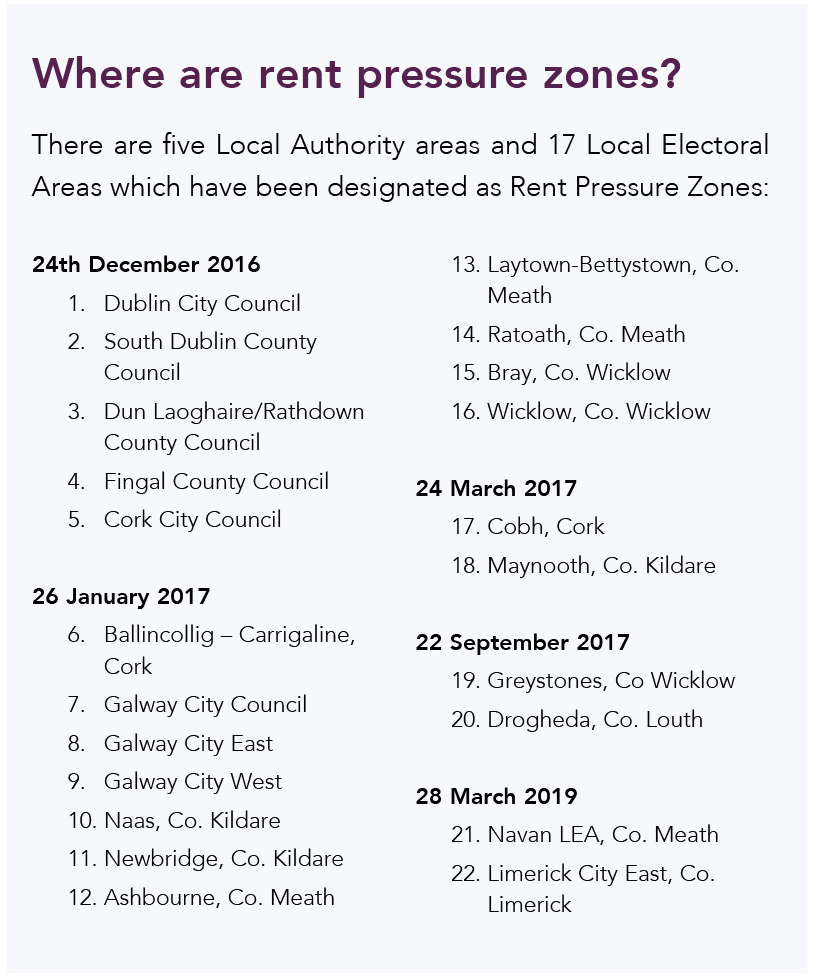
Neighbourhood regeneration
17th May 2019
Leading change and doing things differently
17th May 2019Two new areas meet the rent pressure zone criteria

Two new areas have been designated as rent pressure zones, the first time new areas have been added to the scheme since 2017. However, while it is estimated that national rents are some 7 per cent higher than the previous year, Q4 2018 marked the first time that the standardised average rent has fallen relative to the previous quarter since the first three months of 2017.
Rent pressure zones (RPZs) are areas where rents are above average national rent level and have experienced rental inflation of in excess of 7 per cent in four of the last six quarters. Legislation introduced by former Housing Minister Simon Coveney TD provided that annual rent increases in Rent Pressure Zones will be limited to 4 per cent.
According to the latest Rent Index from the Residential Tenancies Board (RTB), in the October-December period of 2018, the standardised national average rent was €1,134 per month, up from €1,061 one year earlier (a €73 increase). Conversely, on a quarter-on-quarter basis, rental price inflation dropped from 2.3 per cent in Q3 2018, down to -0.3 per cent in Q4 2018. This marks the first quarter since Q1 2017 that the standardised average rent has fallen relative to the previous quarter.
The RTB Rent Index, which is compiled in conjunction with the Economic and Social Research Institute (ESRI), is the authoritative guide to the Irish rental market. It is based on actual rents paid on 17,830 tenancies registered with the RTB in the quarter.
Based on the rental data of the latest Rent Index, two additional LEAs meet the designation criteria for rent pressure zones (RPZs); Navan in County Meath and Limerick City East. The RTB has confirmed to the Minster of Housing that these two local electoral areas (LEAs) meet the RPZ criteria.
Commenting on the latest Rent Index results, Rosalind Carroll, Director of the Residential Tenancies Board says: “The Rent Index has now provided us with important data that enables a decision to be taken on designating two new Rent Pressure Zones to be set for the local electoral areas of Limerick City East and Navan.
“These are the first RPZs to be designated since September 2017. This is important for landlords and tenants as it means that rents in these LEAs will be limited to rises of a maximum of 4 per cent annually.
“This should help moderate rents in these areas. We would encourage both landlords and tenants to contact us for more information on their rights and obligations and we will be rolling out a targeted information campaign in these areas over the coming weeks.”
She continues: “Looking back over 2018, we have seen another year with continued pressures in the market and continued rent inflation, with rents now 15 per cent higher nationally than the peak in 2007, and 25 per cent higher in the Dublin market.
“We have seen some moderation in the market in the last two quarters, we would hope with more supply coming on stream and the RTB getting more regulatory powers that we will see further easing of rent inflation in 2019.”
There are five local authority areas and 17 local electoral areas which have been designated as rent pressure zones. All of Dublin and Cork city were the first places to be designated as RPZs.
The scheme has both its advocates and its critics. Landlords have claimed that the strict criteria is pushing property owners out of the rental market. On the other hand, it has been suggested that too many loopholes exist for landlords to make their property exempt from restrictions.
Not all properties in rent pressure zones are subject to the 4 per cent restriction with exempt properties including those that are new to the rental market and have not been let at any time in the previous two years, and those that have undergone a ‘substantial change in the nature of the accommodation’.
The RTB says that a ‘substantial change’ must be a significant change or improvement to the dwelling which results in increased market value of the tenancy and therefore adds to the letting value of the property. However, there has been criticism levelled that this clause facilitates the eviction of tenants for work to be done to a property and significantly higher rents to be charged to new tenants.
Dublin’s rental market continues to be the largest in the country in quarter four 2018, accounting for nearly two-in-five new tenancies that were registered with the RTB. The standardised average rent in Dublin stood at €1,650, up from €1,530 one year earlier. This represents a 7.8 per cent annual increase in rent in the capital. However, the standard average rent was slightly lower in Q4 compared to Q3, going from €1,663 to €1,650.
Elsewhere in the country, the second highest standardised average rents in Q4 2018 were in Cork City at €1,095 per month. Galway City standardised average rents stood at €1,064 for Q4 2018, rents in Limerick City were €929 and rents in Waterford City were €682.
Minister Eoghan Murphy TD has stated his belief that rent caps are working but says they needed to be strengthened and extended. Having passed through the Dáil, the Residential Tenancies (Amendment) (No. 2) Bill 2018 is expected to be signed into law in June.
The Act will:
• provide for powers to carry out investigations of landlords and impose administrative sanctions;
• provide for offences in relation to non-compliance with rent increase restrictions in rent pressure zones;
• increase the notice periods to be provided in the case of termination of a tenancy by a landlord; to provide for annual registration by landlords of tenancies and to amend the registration process; and
• provide for mandatory publication of determination orders by the Residential Tenancies Board; and to provide for related matters.
Describing the reforms as the “most significant rental sector reforms in recent years”, he states his belief that “they will bring greater affordability and security for people who are renting”.
“Not only are we now extending rent controls out to the end of 2021, we are also changing the criteria to capture more areas experiencing high rent inflation and closing down avenues that allowed some landlords to escape rent controls,” he adds.
“In addition, we are strengthening security of tenure provisions for tenants, and also extending notice to quit periods. This will help those in housing insecurity while also giving more time for people to find new accommodation where necessary.
“Rebuilding Ireland is working to dramatically increase the supply of new homes, to rent and to buy, which is the fundamental problem in our housing sector. As supply increases, we can do more to protect people in housing insecurity, to protect renters against unaffordable rents, and in doing both, prevent more people from having to enter emergency accommodation.”







